Mechanical and Electrical Characteristics of Lightweight Aggregate Concrete Reinforced with Steel Fibers
Abstract
:1. Introduction
2. Experimental Program
2.1. Mix Design and Materials
2.2. Test Methods and Preparation of Specimens
3. Experimental Results and Discussion
3.1. Density Characterisitcs
3.1.1. Equilibrium Density
3.1.2. Dry Density
3.2. Mechanical Characterisitcs
3.2.1. Compressive Strength
3.2.2. Flexural Strength
3.3. Electrical Characterisitcs
3.3.1. Electrical Resistivity
3.3.2. Shielding Effectiveness
4. Conclusions
- The density of concrete decreased when all coarse aggregates were replaced with lightweight coarse aggregates. Despite the addition of steel fibers, LC-SS15F had an equilibrium density of 2119 kg/m3, satisfying the density requirement for lightweight aggregate concrete.
- The compressive and flexural strengths decreased when the lightweight coarse aggregate was incorporated. However, the strength and ductile performance improved with the incorporation of steel fibers.
- The lightweight coarse aggregate contained metallic Fe2O3 and Al2O3, which improved the electrical conductivity of the concrete. In addition, steel fibers formed the best electrically conductive path by entangling inside the concrete.
- When 0.75% steel fiber content was used, the shielding effectiveness of the concrete increased by at least 23.0 dB. In addition, the CFRP rebars exhibited improved conductivity, and shielding effectiveness similar to those of the steel rebars. However, reducing the CFRP rebar spacing of SFRC from 100 to 50 mm had an insignificant influence on the shielding effectiveness.
Author Contributions
Funding
Institutional Review Board Statement
Informed Consent Statement
Data Availability Statement
Conflicts of Interest
References
- Yehia, S.; Qaddoumi, N.; Hassan, M.; Swaked, B. Conductive concrete for electromagnetic shielding applications. Adv. Civ. Eng. Mater. 2014, 3, 270–290. [Google Scholar] [CrossRef] [Green Version]
- Hyun, S.-Y.; Lee, K.-W.; Kim, M.-S.; Yook, J.-G. Electromagnetic modeling of shielding effectiveness of reinforced concrete walls. J. Korea Inst. Electromag. Eng. Sci. 2012, 23, 384–391. [Google Scholar] [CrossRef] [Green Version]
- Choi, J.; Yuan, T.; Hong, S.; Yoon, Y. Evaluating of electromagnetic shielding characteristics of reinforced concrete using reinforcing details. J. Korean Soc. Hazard Mitig. 2020, 20, 245–254. [Google Scholar] [CrossRef]
- Chung, D.D.L. Materials for electromagnetic interference shielding. Mater. Chem. Phys. 2020, 255, 123587. [Google Scholar] [CrossRef]
- Hyun, S.-Y.; Du, J.-K.; Lee, H.-J.; Lee, K.-W.; Lee, J.-H.; Jung, C.; Kim, E.-J.; Kim, W.; Yook, J.-G. Analysis of shielding effectiveness of reinforced concrete against high-altitude electromagnetic pulse. IEEE Trans. Electromagn. Compat. 2014, 56, 1488–1496. [Google Scholar] [CrossRef]
- Ozturk, M.; Karaaslan, M.; Akgol, O.; Sevim, U.K. Mechanical and electromagnetic performance of cement based composites containing different replacement levels of ground granulated blast furnace slag, fly ash, silica fume and rice husk ash. Cem. Concr. Res. 2020, 136, 106177. [Google Scholar] [CrossRef]
- Kim, K.-Y. A Study on Electromagnetic Interference Shielding Effectiveness of Composites with Conductive Filler. Master’s Thesis, Chosun University, Gwangju, Korea, 2011. [Google Scholar]
- Wanasinghe, D.; Aslani, F.; Ma, G. Electromagnetic shielding properties of carbon fibre reinforced cementitious composites. Constr. Build. Mater. 2020, 260, 120439. [Google Scholar] [CrossRef]
- Jung, M.; Lee, Y.-s.; Hong, S.-G.; Moon, J. Carbon nanotubes (CNTs) in ultra-high performance concrete (UHPC): Dispersion, mechanical properties, and electromagnetic interference (EMI) shielding effectiveness (SE). Cem. Concr. Res. 2020, 131, 106017. [Google Scholar] [CrossRef]
- Yoo, D.-Y.; Kang, M.-C.; Choi, H.-J.; Shin, W.; Kim, S. Electromagnetic interference shielding of multi-cracked high-performance fiber-reinforced cement composites–Effects of matrix strength and carbon fiber. Constr. Build. Mater. 2020, 261, 119949. [Google Scholar] [CrossRef]
- Wang, Z.; Zhang, T.; Zhou, L. Investigation on electromagnetic and microwave absorption properties of copper slag-filled cement mortar. Cem. Concr. Compos. 2016, 74, 174–181. [Google Scholar] [CrossRef]
- Ding, S.; Dong, S.; Ashour, A.; Han, B. Development of sensing concrete: Principles, properties and its applications. J. Appl. Phys. 2019, 126, 241101. [Google Scholar] [CrossRef] [Green Version]
- Zhang, X.; Sun, W. Electromagnetic shielding and absorption properties of fiber reinforced cementitious composites. J. Wuhan Univ. Technol.-Mater. Sci. Ed. 2012, 27, 172–176. [Google Scholar] [CrossRef]
- Ozturk, M.; Akgol, O.; Sevim, U.K.; Karaaslan, M.; Demirci, M.; Unal, E. Experimental work on mechanical, electromagnetic and microwave shielding effectiveness properties of mortar containing electric arc furnace slag. Constr. Build. Mater. 2018, 165, 58–63. [Google Scholar] [CrossRef]
- Hong, S.-H.; Choi, J.-S.; Lee, J.; Yoon, Y.-S. Optimal mix design and quality properties of 50 MPa self-consolidating lightweight concrete. J. Korean Soc. Hazard Mitig. 2020, 20, 135–142. [Google Scholar] [CrossRef]
- Kim, Y.-H.; Kim, H.-Y.; Yang, K.-H.; Ha, J.-S. Evaluation of workability and mechanical properties of bottom ash aggregate concrete. Appl. Sci. 2020, 10, 8016. [Google Scholar] [CrossRef]
- Kim, H.-K.; Lee, H.-K. Use of power plant bottom ash as fine and coarse aggregates in high-strength concrete. Constr. Build. Mater. 2011, 25, 1115–1122. [Google Scholar] [CrossRef]
- Kim, Y.-H.; Kim, H.-Y.; Yang, K.-H.; Ha, J.-S. Effect of concrete unit weight on the mechanical properties of bottom ash aggregate concrete. Constr. Build. Mater. 2021, 273, 121998. [Google Scholar] [CrossRef]
- Alqahtani, F.K. Sustainable green lightweight concrete containing plastic-based green lightweight aggregate. Materials 2021, 14, 3304. [Google Scholar] [CrossRef]
- Domagała, L. Durability of structural lightweight concrete with sintered fly ash aggregate. Materials 2020, 13, 4565. [Google Scholar] [CrossRef]
- Pekgöz, M.; Tekin, İ. Microstructural investigation and strength properties of structural lightweight concrete produced with zeolitic tuff aggregate. J. Build. Eng. 2021, 43, 102863. [Google Scholar] [CrossRef]
- Ankur, N.; Singh, N. Performance of cement mortars and concretes containing coal bottom ash: A comprehensive review. Renew. Sustain. Energy Rev. 2021, 149, 111361. [Google Scholar] [CrossRef]
- Sahoo, S.; Selvaraju, A.K. Mechanical characterization of structural lightweight aggregate concrete made with sintered fly ash aggregates and synthetic fibres. Cem. Concr. Compos. 2020, 113, 103712. [Google Scholar] [CrossRef]
- Wu, F.; Liu, C.; Sun, W.; Zhang, L.; Ma, Y. Mechanical and creep properties of concrete containing apricot shell lightweight aggregate. KSCE J. Civ. Eng. 2019, 23, 2948–2957. [Google Scholar] [CrossRef]
- Agrawal, Y.; Gupta, T.; Sharma, R.; Panwar, N.L.; Siddique, S. A comprehensive review on the performance of structural lightweight aggregate concrete for sustainable construction. Constr. Mater. 2021, 1, 39–62. [Google Scholar]
- Shafigh, P.; Chai, L.J.; Mahmud, H.B.; Nomeli, M.A. A comparison study of the fresh and hardened properties of normal weight and lightweight aggregate concretes. J. Build. Eng. 2018, 15, 252–260. [Google Scholar] [CrossRef]
- Kim, K.; Jung, S. State-of-the-art of FRP reinforcement for concrete structure. J. Korea Concr. Inst. 2019, 31, 29–33. [Google Scholar]
- Zhao, J.; Luo, X.; Wang, Z.; Feng, S.; Gong, X.; Shumuye, E.D. Experimental study on bond performance of carbon-and glass-fiber reinforced polymer (CFRP/GFRP) bars and steel strands to concrete. Materials 2021, 14, 1268. [Google Scholar] [CrossRef]
- Sovják, R.; Havlásek, P.; Vítek, J. Long-term behavior of concrete slabs prestressed with CFRP rebars subjected to four-point bending. Constr. Build. Mater. 2018, 188, 781–792. [Google Scholar] [CrossRef]
- Wang, L.; Yi, J.; Zhang, J.; Chen, W.; Fu, F. Short-term flexural stiffness prediction of CFRP bars reinforced coral concrete beams. Materials 2021, 14, 467. [Google Scholar] [CrossRef]
- Hong, S.; Yuan, T.; Choi, J.; Yoon, Y. Evaluating microstructure and self-sensing properties of high-strength concrete with electric-arc-furnace oxidizing slag. J. Korean Soc. Hazard Mitig. 2019, 19, 189–197. [Google Scholar] [CrossRef] [Green Version]
- Hong, S.-H.; Yuan, T.-F.; Choi, J.-S.; Yoon, Y.-S. Assessing the effects of steelmaking slag powder on the pore structure and durability of concrete. J. Korean Soc. Hazard Mitig. 2021, 21, 1–11. [Google Scholar] [CrossRef]
- Roslan, N.H.; Ismail, M.; Abdul-Majid, Z.; Ghoreishiamiri, S.; Muhammad, B. Performance of steel slag and steel sludge in concrete. Constr. Build. Mater. 2016, 104, 16–24. [Google Scholar] [CrossRef]
- Hong, S.-H.; Yuan, T.-F.; Choi, J.-S.; Yoon, Y.-S. Effects of steelmaking slag and moisture on electrical properties of concrete. Materials 2020, 13, 2675. [Google Scholar] [CrossRef]
- Lee, J.-Y.; Choi, J.-S.; Yuan, T.-F.; Yoon, Y.-S.; Mitchell, D. Comparing properties of concrete containing electric arc furnace slag and granulated blast furnace slag. Materials 2019, 12, 1371. [Google Scholar] [CrossRef] [Green Version]
- ASTM C33: Standard Specification for Concrete Aggregates; ASTM International: West Conshohocken, PA, USA, 2018.
- ASTM C330: Standard Specification for Lightweight Aggregates for Structural Concrete; ASTM International: West Conshohocken, PA, USA, 2017.
- Muthusamy, K.; Rasid, M.H.; Jokhio, G.A.; Budiea, A.M.A.; Hussin, M.W.; Mirza, J. Coal bottom ash as sand replacement in concrete: A review. Constr. Build. Mater. 2020, 236, 117507. [Google Scholar] [CrossRef]
- ASTM C567: Standard Test Method for Determining Density of Structural Lightweight Concrete; ASTM International: West Conshohocken, PA, USA, 2020.
- ASTM C39: Standard Test Method for Compressive Strength of Cylindrical Concrete Specimens; ASTM International: West Conshohocken, PA, USA, 2020.
- ASTM C1609: Standard Test Method for Flexural Performance of Fiber-Reinforced Concrete (Using Beam with Third-Point Loading); ASTM International: West Conshohocken, PA, USA, 2020.
- You, I.; Yoo, D.-Y.; Kim, S.; Kim, M.-J.; Zi, G. Electrical and self-sensing properties of ultra-high-performance fiber-reinforced concrete with carbon nanotubes. Sensors 2017, 17, 2481. [Google Scholar] [CrossRef] [Green Version]
- Xue, J.; Wang, X.; Wang, Z.; Xu, S.; Liu, H. Investigations on influencing factors of resistivity measurement for graphite tailings concrete. Cem. Concr. Compos. 2021, 123, 104206. [Google Scholar] [CrossRef]
- ACI 318-19: Building Code Requirements for Structural Concrete; American Concrete Institute: Farmington Hills, MI, USA, 2019.
- ACI 440.1R: Guide for the Design and Construction of Structural Concrete Reinforced with Fiber-Reinforced Polymer (FRP) Bars; American Concrete Institute: Farmington Hills, MI, USA, 2015.
- Roslan, N.H.; Ismail, M.; Khalid, N.H.A.; Muhammad, B. Properties of concrete containing electric arc furnace steel slag and steel sludge. J. Build. Eng. 2020, 28, 101060. [Google Scholar] [CrossRef]
- Wongsa, A.; Zaetang, Y.; Sata, V.; Chindaprasirt, P. Properties of lightweight fly ash geopolymer concrete containing bottom ash as aggregates. Constr. Build. Mater. 2016, 111, 637–643. [Google Scholar] [CrossRef]
- Park, S.B.; Jang, Y.I.; Lee, J.; Lee, B.J. An experimental study on the hazard assessment and mechanical properties of porous concrete utilizing coal bottom ash coarse aggregate in Korea. J. Hazard. Mater. 2009, 166, 348–355. [Google Scholar] [CrossRef]
- Lee, S.Y.; Le, H.V.; Kim, D.J. Self-stress sensing smart concrete containing fine steel slag aggregates and steel fibers under high compressive stress. Constr. Build. Mater. 2019, 220, 149–160. [Google Scholar] [CrossRef]
- Baeza, F.J.; Galao, O.; Vegas, I.J.; Cano, M.; Garcés, P. Influence of recycled slag aggregates on the conductivity and strain sensing capacity of carbon fiber reinforced cement mortars. Constr. Build. Mater. 2018, 184, 311–319. [Google Scholar] [CrossRef]
- Cleven, S.; Raupach, M.; Matschei, T. Electrical resistivity of steel fibre-reinforced concrete—Influencing parameters. Materials 2021, 14, 3408. [Google Scholar] [CrossRef] [PubMed]
- Baoyi, L.; Yuping, D.; Yuefang, Z.; Shunhua, L. Electromagnetic wave absorption properties of cement-based composites filled with porous materials. Mater. Des. 2011, 32, 3017–3020. [Google Scholar] [CrossRef]
- Fan, Y.; Zhang, L.; Volski, V.; Vandenbosch, G.A.E.; Blanpain, B.; Guo, M. Utilization of stainless-steel furnace dust as an admixture for synthesis of cement-based electromagnetic interference shielding composites. Sci. Rep. 2017, 7, 15368. [Google Scholar] [CrossRef] [Green Version]
- Chen, J.; Zhao, D.; Ge, H.; Wang, J. Graphene oxide-deposited carbon fiber/cement composites for electromagnetic interference shielding application. Constr. Build. Mater. 2015, 84, 66–72. [Google Scholar] [CrossRef]
- Wen, S.; Chung, D.D.L. Electromagnetic interference shielding reaching 70 dB in steel fiber cement. Cem. Concr. Res. 2004, 34, 329–332. [Google Scholar] [CrossRef]
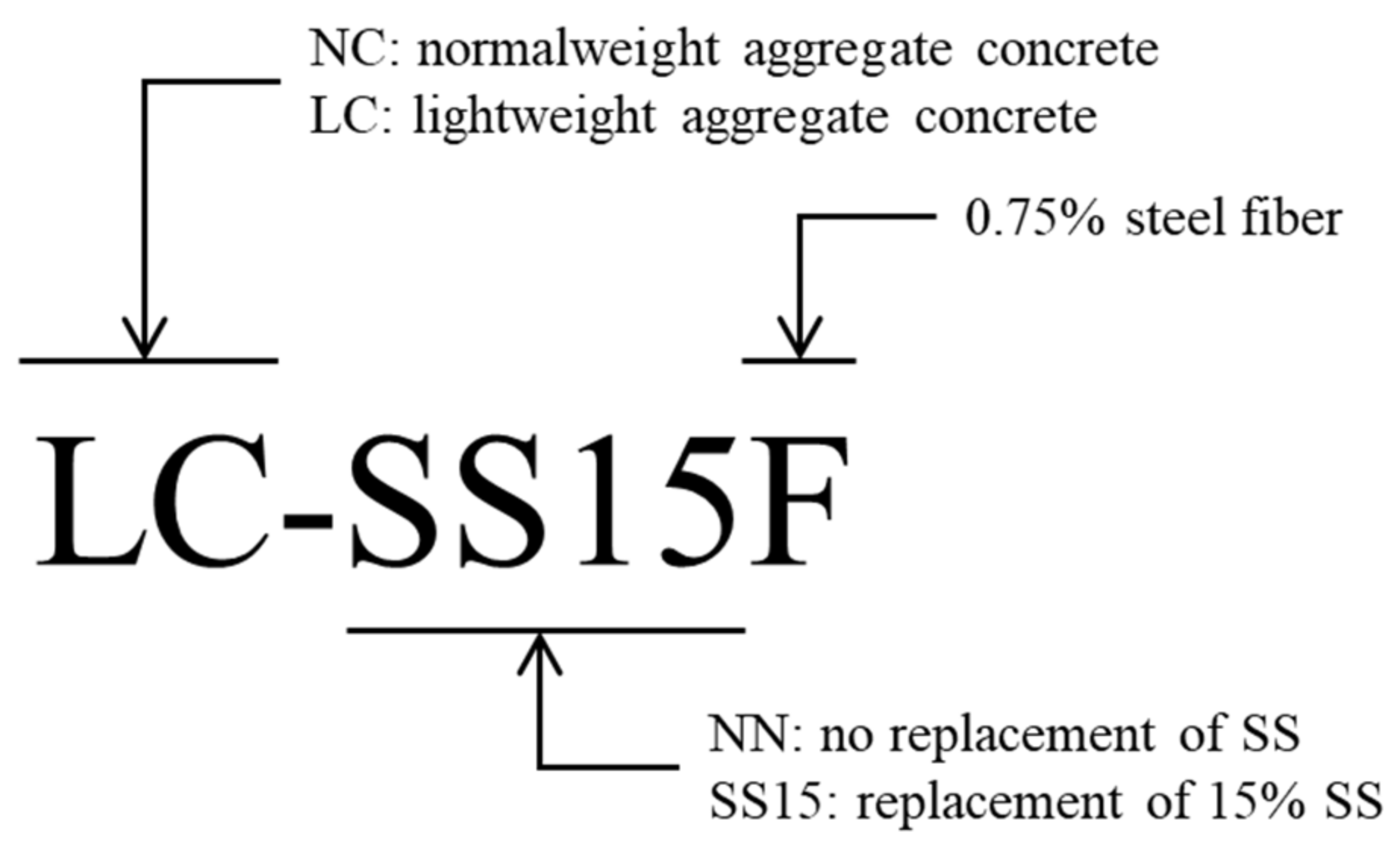

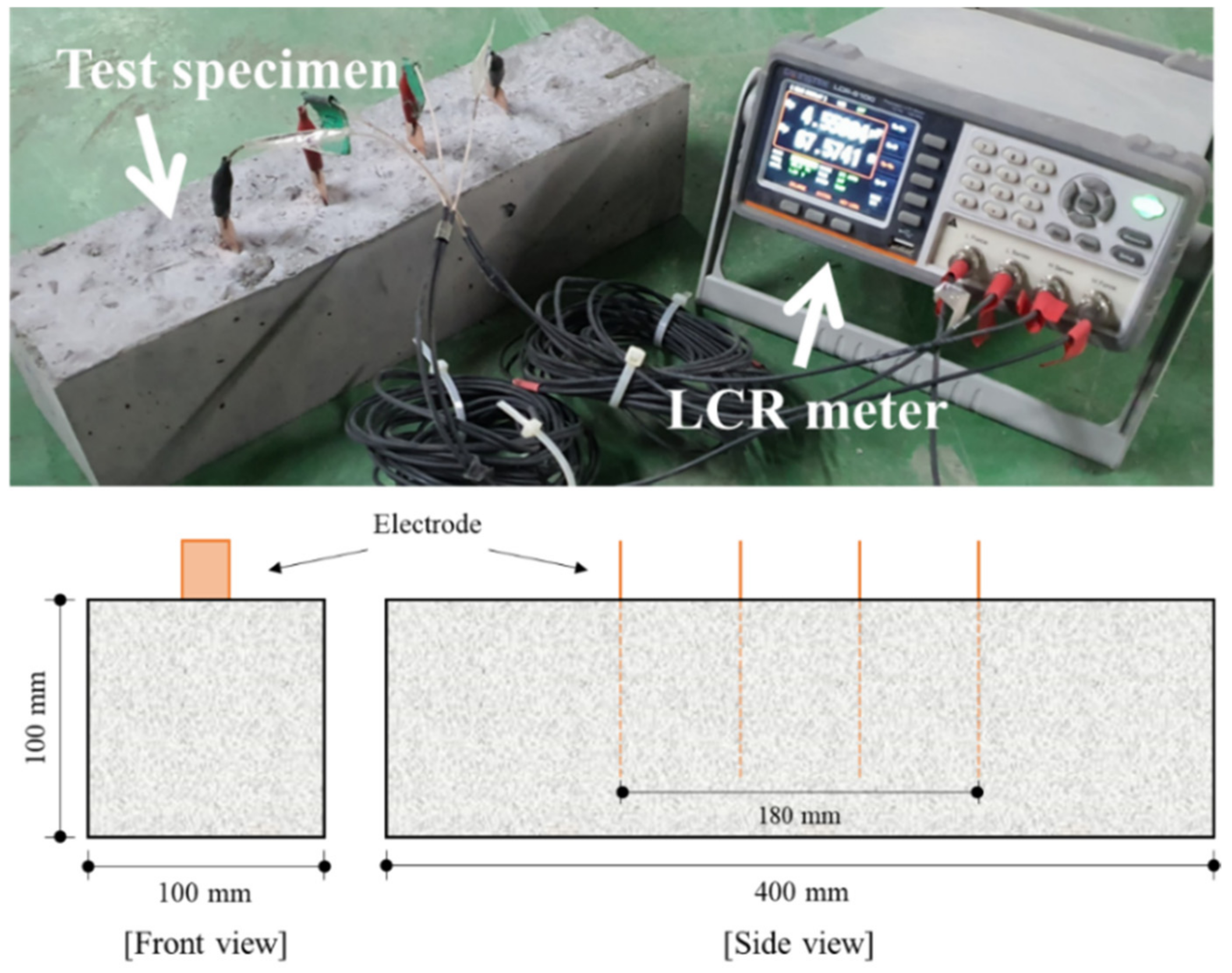
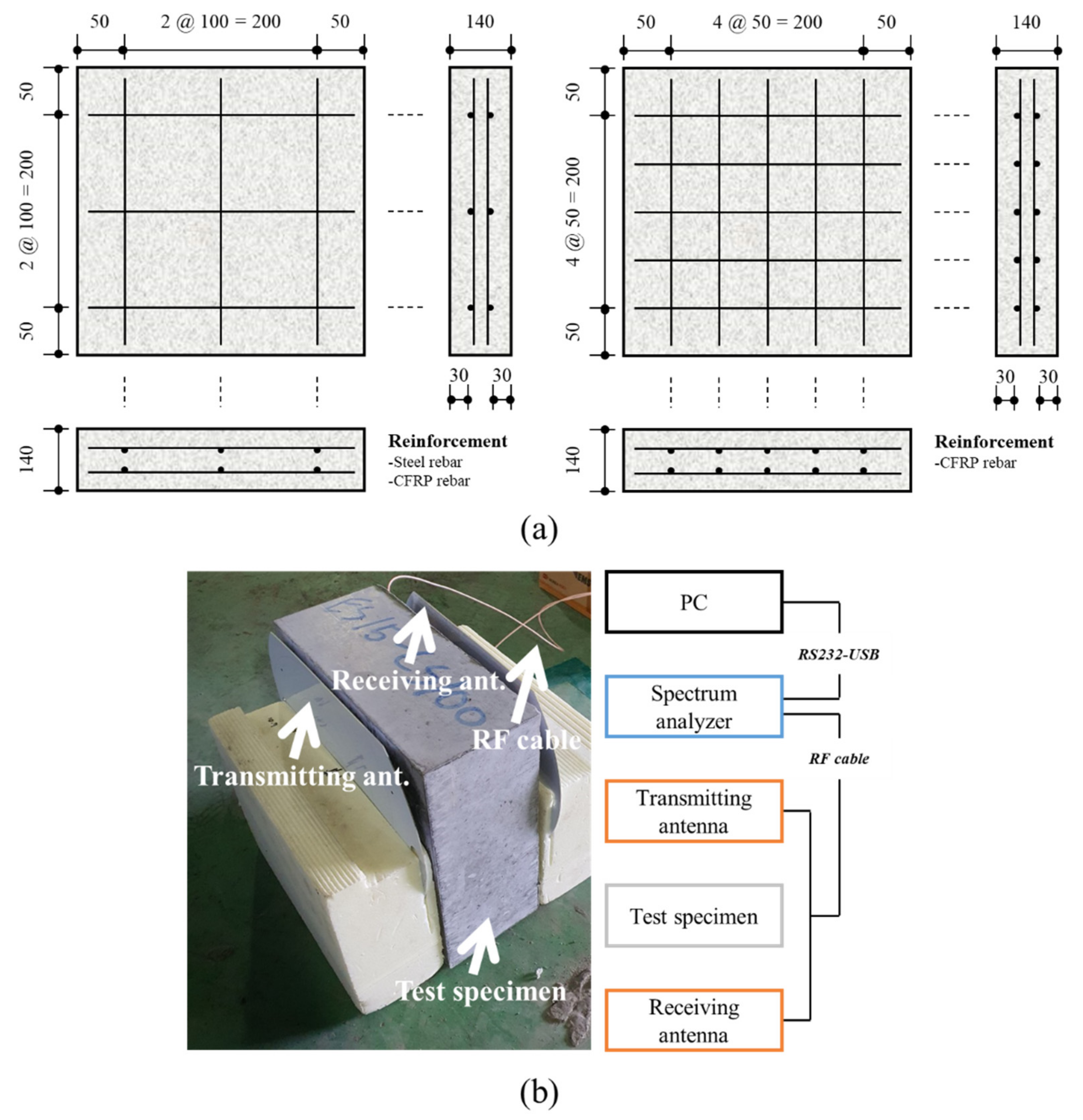
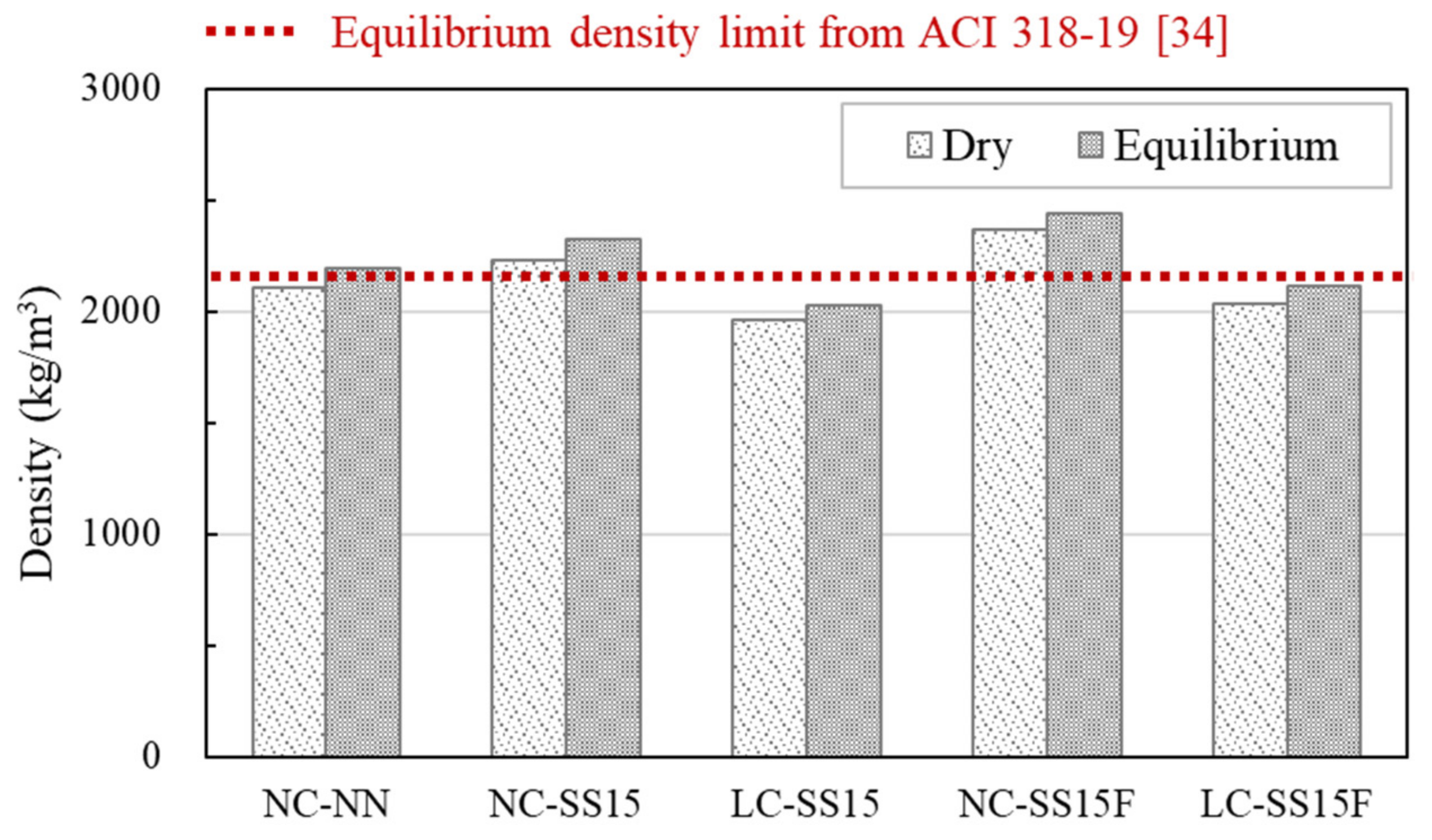
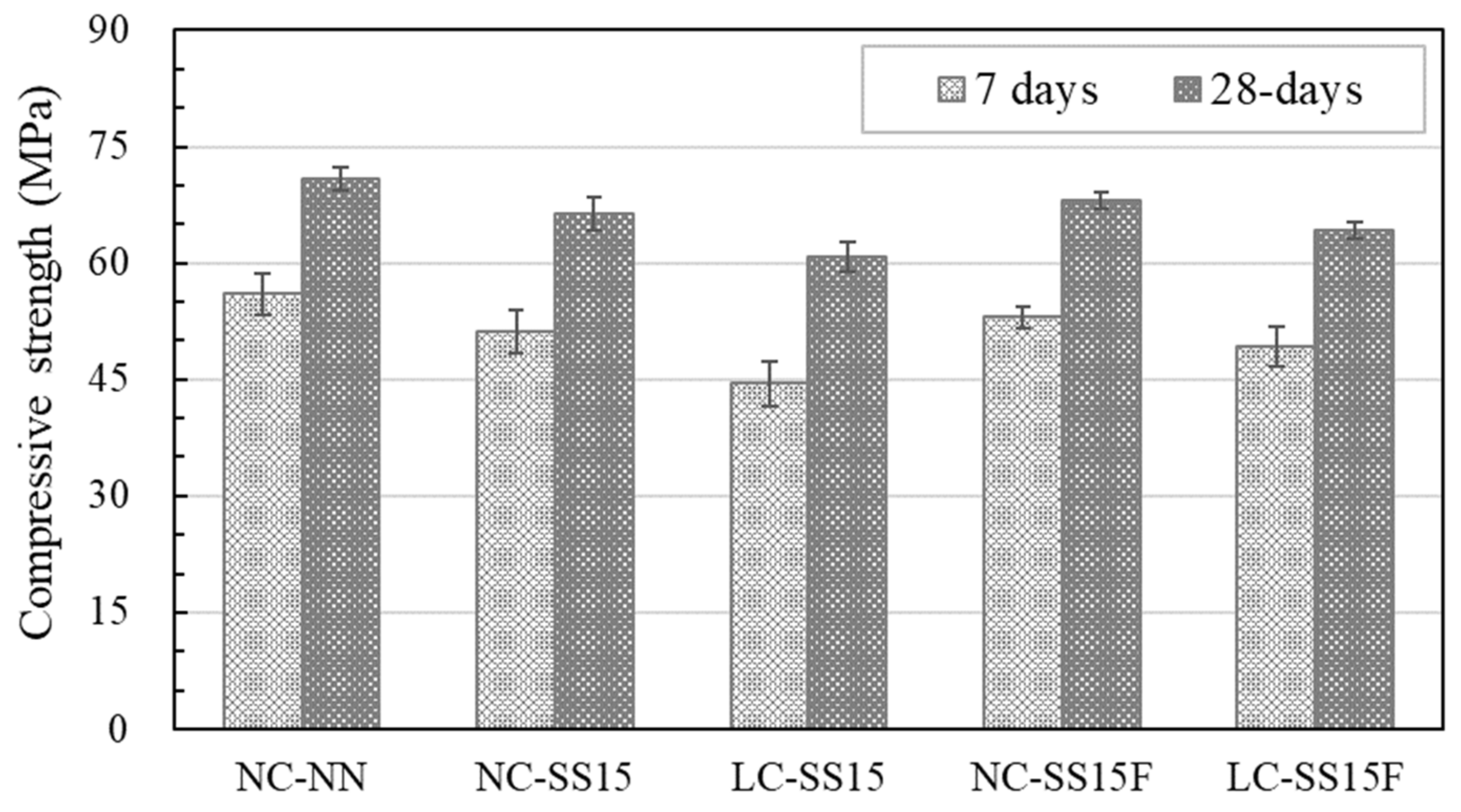
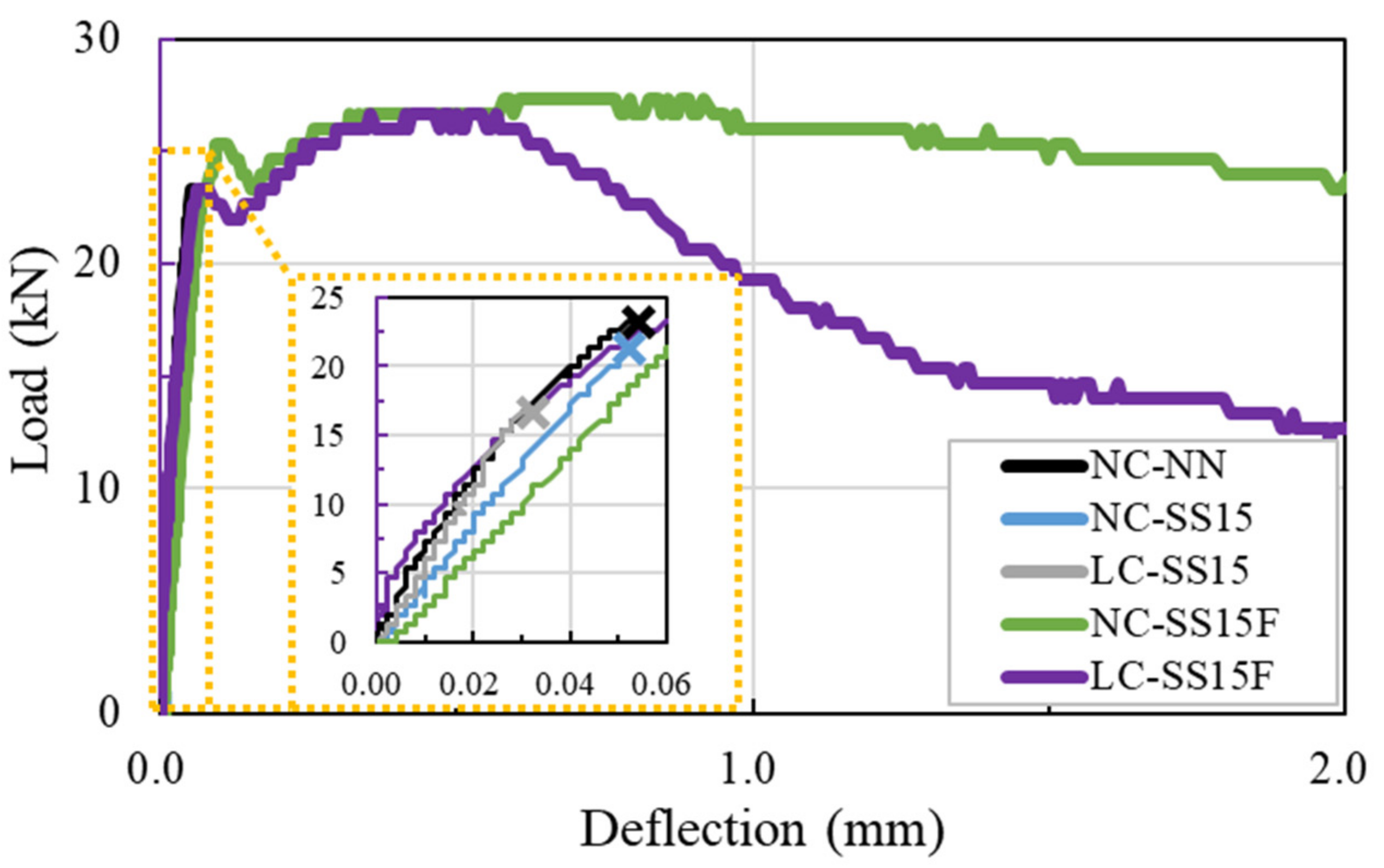
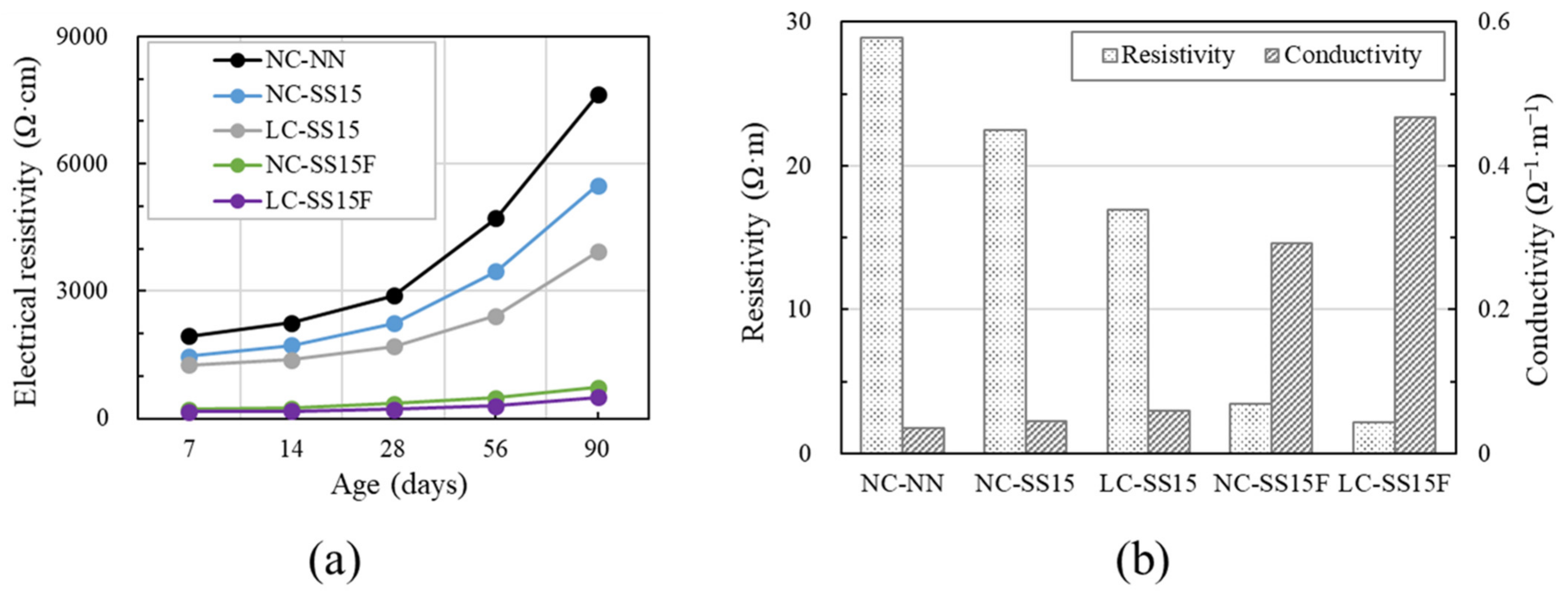
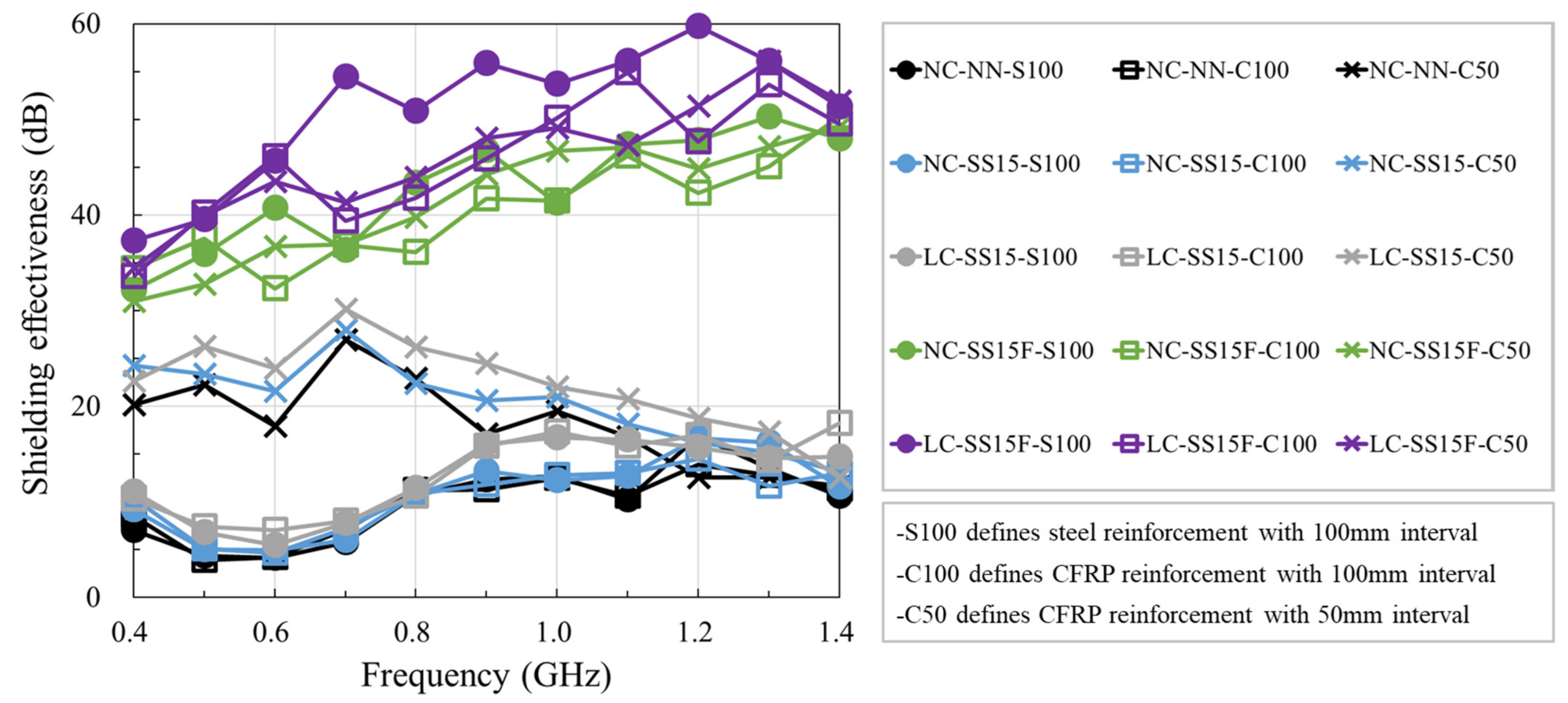

| Mix | w/b * | By Cement Weight Ratio | F (%) | SP ** (%) | AEA ** (%) | Slump (mm) | |||||
|---|---|---|---|---|---|---|---|---|---|---|---|
| W | C | SS | FA | CA | LCA | ||||||
| NC-NN | 0.325 | 0.32 | 1.00 | - | 1.25 | 1.86 | - | - | 0.57 | 0.02 | 175 |
| NC-SS15 | 0.325 | 0.38 | 1.00 | 0.18 | 1.48 | 2.18 | - | - | 0.67 | 0.02 | 210 |
| LC-SS15 | 0.200 | 0.24 | 1.00 | 0.18 | 0.86 | - | 0.84 | - | 0.66 | 0.02 | 155 |
| NC-SS15F | 0.325 | 0.38 | 1.00 | 0.18 | 1.48 | 2.18 | - | 0.75 | 0.76 | 0.02 | 200 |
| LC-SS15F | 0.200 | 0.24 | 1.00 | 0.18 | 0.86 | - | 0.84 | 0.75 | 0.69 | 0.02 | 175 |
| Content | Binders | Aggregates | ||||
|---|---|---|---|---|---|---|
| C | SS | FA | CA | LCA | ||
| Chemical composition (% mass) | SiO2 | 17.9 | 14.2 | 66.8 | 61.8 | 60.9 |
| CaO | 65.5 | 22.1 | 1.43 | 2.51 | 3.49 | |
| Al2O3 | 4.67 | 11.1 | 17.6 | 17.8 | 17.0 | |
| Fe2O3 | 2.79 | 39.9 | 2.38 | 4.54 | 9.64 | |
| MgO | 2.65 | 3.33 | 0.85 | 3.76 | 1.89 | |
| SO3 | 4.65 | 0.02 | 0.25 | 0.77 | 0.13 | |
| MnO | 0.10 | 5.59 | 0.06 | 0.10 | 0.11 | |
| TiO2 | 0.27 | 0.69 | 0.31 | 0.76 | 1.01 | |
| K2O | 0.95 | 0.05 | 4.45 | 3.72 | 0.91 | |
| Na2O | 0.19 | 0.02 | 4.32 | 2.82 | 1.14 | |
| Physical properties | Density (g/cm3) | 3.15 | 3.96 | 2.60 | 2.67 | 1.87 |
| Blaine (cm2/g) | 3413 | 4893 | - | - | - | |
| Fineness modulus | - | - | 2.88 | 6.63 | 6.74 | |
| Type | db (mm) | Ar (mm2) | fy (MPa) | fu (MPa) | E (GPa) |
|---|---|---|---|---|---|
| Steel | 10 | 71.3 | 400 | 572 | 200 |
| CFRP | 10 | 71.3 | - | 2300 | 130 |
| Specimen | Max. Load (kN) | Deflection at Max. Load (mm) | Flexural Strength (MPa) | Toughness at L/150 (J) |
|---|---|---|---|---|
| NC-NN | 23.32 | 0.054 | 7.0 | - |
| NC-SS15 | 21.32 | 0.052 | 6.4 | - |
| LC-SS15 | 16.66 | 0.032 | 5.0 | - |
| NC-SS15F | 27.32 | 0.578 | 8.2 | 50.60 |
| LC-SS15F | 26.66 | 0.354 | 8.0 | 38.55 |
| Specimen | Electrical Resistivity | Electrical Conductivity | ||
|---|---|---|---|---|
| Value (Ω·m) | S.D. | Value (Ω·m)−1 | S.D. | |
| NC-NN | 28.95 | 8.30 × 10−2 | 0.03 | 9.90 × 10−5 |
| NC-SS15 | 22.47 | 9.43 × 10−3 | 0.04 | 1.87 × 10−5 |
| LC-SS15 | 16.94 | 2.07 × 10−2 | 0.06 | 7.23 × 10−5 |
| NC-SS15F | 3.42 | - | 0.29 | - |
| LC-SS15F | 2.14 | 1.89 × 10−3 | 0.47 | 4.11 × 10−4 |
Publisher’s Note: MDPI stays neutral with regard to jurisdictional claims in published maps and institutional affiliations. |
© 2021 by the authors. Licensee MDPI, Basel, Switzerland. This article is an open access article distributed under the terms and conditions of the Creative Commons Attribution (CC BY) license (https://creativecommons.org/licenses/by/4.0/).
Share and Cite
Hong, S.-H.; Choi, J.-S.; Yuan, T.-F.; Yoon, Y.-S. Mechanical and Electrical Characteristics of Lightweight Aggregate Concrete Reinforced with Steel Fibers. Materials 2021, 14, 6505. https://doi.org/10.3390/ma14216505
Hong S-H, Choi J-S, Yuan T-F, Yoon Y-S. Mechanical and Electrical Characteristics of Lightweight Aggregate Concrete Reinforced with Steel Fibers. Materials. 2021; 14(21):6505. https://doi.org/10.3390/ma14216505
Chicago/Turabian StyleHong, Se-Hee, Jin-Seok Choi, Tian-Feng Yuan, and Young-Soo Yoon. 2021. "Mechanical and Electrical Characteristics of Lightweight Aggregate Concrete Reinforced with Steel Fibers" Materials 14, no. 21: 6505. https://doi.org/10.3390/ma14216505
APA StyleHong, S.-H., Choi, J.-S., Yuan, T.-F., & Yoon, Y.-S. (2021). Mechanical and Electrical Characteristics of Lightweight Aggregate Concrete Reinforced with Steel Fibers. Materials, 14(21), 6505. https://doi.org/10.3390/ma14216505








